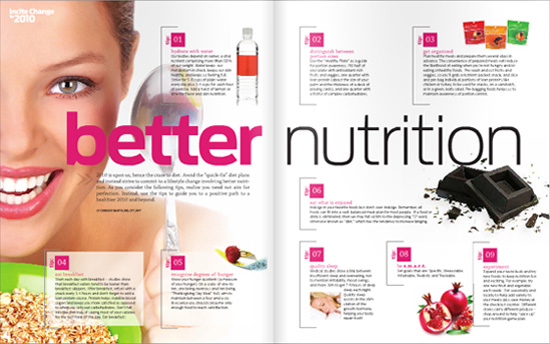Better Nutrition
2010 is upon us, hence the craze to diet. Avoid the "quick-fix" diet plans and instead strive to commit to a lifestyle change involving better nutrition. As you consider the following tips, realize you need not aim for perfection. Instead, use the tips to guide you to a positive path to a healthier 2010 and beyond.
by CHRISSY BARTH, RD, CFT, RYT
TIP 1: HYDRATE WITH WATER:
Our bodies depend on water, a vital nutrient comprising more than 50% of our weight. Water keeps our metabolism in check, keeps our skin healthy, and keeps us feeling full. Strive for 5-8 cups of plain water every day plus 3-4 cups for each hour of exercise. Add a twist of lemon or lime for flavor and skin nutrition.
TIP 2: DISTINGUISH BETWEEN PORTION SIZES:
Use the “Healthy Plate” as a guide for portion awareness. Fill half of your plate with antioxidant-rich fruits and veggies, one quarter with lean protein (about the size of your palm and the thickness of a deck of playing cards), and one quarter with a fistful of complex carbohydrates.
TIP 3: GET ORGAZINED:
Plan healthy meals and prepare them several days in
advance. The convenience of prepared meals will reduce
the likelihood of eating when you’re not hungry and/or
eating unhealthy foods. Pre-wash and cut fruits and
veggies, so you’ll grab a nutrient-packed snack, and slice
and pre-bag individual portions of lean protein, like
chicken or turkey, to be used for snacks, on a sandwich,
or in a green, leafy salad. Pre-bagging foods helps us to
maintain awareness of portion control..
TIP 4: EAT BREAKFAST:
Start each day with breakfast – studies show
that breakfast eaters tend to be leaner than
breakfast skippers. After breakfast, refuel with a
snack every 3-4 hours and don’t forget to add a
lean protein source. Protein helps stabilize blood
sugars and keeps you more satisfied as opposed
to when you only eat carbohydrates. Don’t fall
into the diet trap of saving most of your calories
for the last meal of the day. Eat breakfast!
TIP 5: RECOGNIZE DEGREES OF HUNGER:
This is the ratio of body fat to lean tissue in the body. Know your hunger quotient (a measure
of your hunger). On a scale of one-toten,
one being ravenous and ten being
“Thanksgiving Day Meal” full, aim to
maintain between a four and a six.
In essence you should consume only
enough food to reach satisfaction.
TIP 6: EAT WHAT IS ENJOYABLE:
Indulge in your favorite foods but don’t over-indulge. Remember, all
foods can fit into a well-balanced meal plan for most people. If a food or
drink is eliminated, then we may fall victim to the depressing “D” word,
otherwise known as “diet,” which has the tendency to increase binging
TIP 7: QUALITY SLEEP:
Medical studies show a link between
insufficient sleep and overeating, not
to mention irritability, mood swings,
and more. Aim to get 7-9 hours of deep
sleep each night.
Quality sleep
assists in the stimulation
of the
growth hormone,
helping your body
repair itself.
TIP 8: BE S.M.A.R.T.:
Set goals that are: Specific, Measurable,
Attainable, Realistic and Trackable.
TIP 9: EXPERIMENT:
Expand your taste buds and try
new foods to keep nutrition fun
and exciting. For example, try
one new fruit and vegetable
each week. Eat seasonally and
locally to help add variety to
your meals plus save money at
the checkout counter. Different
stores carry different produce –
shop around to help “spice up”
your nutrition game plan.
Incite Change in 2010 Continued...

